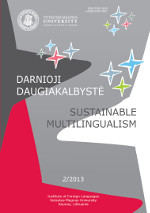Frazeoloģismu apguve augstākajā izglītībā: lingvokulturoloģiskais aspekts
Acquiring Phraseology in Higher Education: Lingua-Cultural Approach
Author(s): Velga LaugaleSubject(s): Foreign languages learning
Published by: Vytauto Didžiojo Universitetas
Keywords: frazeoloģismi; lingvokulturoloģija; lingvokulturēma; kompetence
Summary/Abstract: The article aims at drawing the attention of language teachers to a huge number of phraseologisms which exist in every language and which are traditionally rarely used while teaching and learning languages and cultures. The subject of the research is the experience of the author, namely, the investigation of phraseologisms related with lexicology, the stylistics of lexis and Latvian language for practical uses. Lingvo-culturologic viewpoint to the learning of units of speech takes an important part in the investigations. The question of interaction between language and culture is nowadays relevant in our society, which experiences the growth of global problems, therefore, it is becoming essential to consider the versatility and particularity of behaviour of different nations. Looking at relations between different nations, it is important to foresee potential cultural misunderstandings. It is also important to determine cultural values which form the basis for communicational behaviour. In higher education institutions these skills are obligatory for students who, for various reasons, get into different cultural environments. Until 1990 students were encouraged to memorize word forms and to unpack the meaning of words and only at the end of the 90’s the semantic and practical aspects of speech were highlighted in the process of teaching Latvian as a foreign language. The main unit of lingvo-culturologic viewpoint is lingvocultureme. Lingvocultureme belongs both to language and culture, as it unites the meaning of language and culture which exists outside the boundaries of the language system. Lingvocultureme may be the unit of both lexis and syntax: a word, a phrase, a sentence, a text. Linguistic analysis allows to divide units of language into three types: words and sayings which totally coincide in the languages compared; words and sayings which partially coincide in the languages compared; words and languages which do not coincide in the language compared. Since 2005 various aspects of lingvo-culturology have also been the subject of the project which is carried out by the European Society of Phraseology. The aim of the project is to discover the similarities rather than differences, i.e. to find the part of phraseology which is common for European languages. The results of the previous project show that identical or similar phraseologisms can be found in nearly 50 languages. Idioms with similar lexical and semantic structure can be found even in languages which are not genetically connected and whose areas of usage are distant from each other. It is important to note that each nation has its own cultural vision of the world and a cultural-historic way. In the phraseologisms of each language the culture, the way of thinking and values of each nation are conveyed. Phraseologisms in texts encourage students to search for culturologic information, through which students can develop their communicative, socio-cultural and learning competences.
Journal: Darnioji daugiakalbystė
- Issue Year: 2013
- Issue No: 2
- Page Range: 100-109
- Page Count: 10
- Language: Latvian

